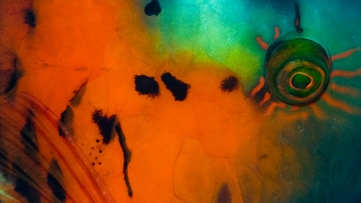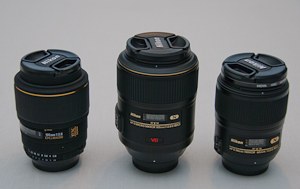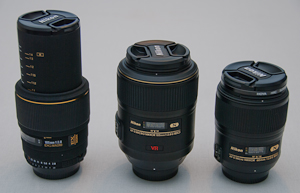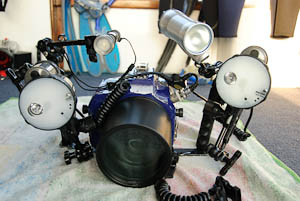
| Home |
| Colors of the Reef |
| Search the Reef |
| Science and the Reef |
| Equipment |
| New |
| Links |
| Contact |
| Interna |
Macro Lenses
 |
 |
| Macro lenses: Sigma 105 mm, Nikkor 105 mm, and Nikkor 60 mm. The picture at the bottom shows the Sigma 105 mm lens extended to 1 : 1.The Nikkors have an inner focus design and thus don't extend et al. |
For the macro lenses flat ports should be used. I use either special flat ports that were customized for the Sigma 17 - 70 mm and the Sigma 105 mm lenses or the Ikelite modular port system with a flat assembly. The latter gives large flexibility to adopt basically all types of lenses, diopters, and teleconverters. The three macro lenses I used are the Nikkor 60 mm, the Nikkor 105 mm, and the Sigma 105 mm. All three are optically excellent lenses that allow to obtain 1 : 1 magnification. The differences are the working distances at maximum magnification and the speed of the auto focus. Since I am using auto focus for underwater macro photography (manual focus for macro on land, but this is a different story) the precision and speed of the auto focus is critical. In this respect the Nikkors with a built in motor are much better than the Sigma lens.
Nikkor 60 mm Micro AF-S 1:2.8G
This is an excellent, very sharp lens for fish photography. As a true macro lens the maximum image size is 1:1. However, to get this magnification one has to very close to the object to be photographed. Not only that many living objects don't like to be approached that close, it is also difficult to position the flashes correctly since there is just not much space left in front of the port. The advantage of this lens is that it is perfect for pictures of small to intermediate size fish and close-ups of larger objects like sharks. In addition, the angle of view is larger than with the 105 mm lens which allows to show also parts of the surrounding of the object.
Nikkor 105 mm Micro AF-S VR 1:2.8G
The 105 mm macro lenses are excellent for small and shy objects in clear water. The small depths of field even when using small apertures results in well isolated objects and blurred backgrounds. However, sometimes it is difficult to find the objects in the viewfinder and focusing can be difficult.
I bought the Nikkor to replace the Sigma 105 mm. The advantage of the Nikkor is the much faster auto focus and the inner focus design, which means that the lens doesn't extend when changing the focus distance. The pictures compare the three macro lenses: Sigma 105 mm (left), Nikkor 105 mm (center) and Nikkor 60 mm (right). While the Sigma in infinite position is almost as short as the 60 mm Nikkor, at 1:1 it is considerably longer than the 105 mm Nikkor. This means, a special, very long port has to be used for the Sigma lens. As a result, the working distance with the Nikkor 105 is considerably larger than with the Sigma 105 mm.
The focusing is precise and fast as long as there is enough ambient light. In most instances I am using a focus light to avoid "hunting" of the auto focus.
 |
| Macro set-up ready to dive. |
Sigma 105 mm 1:2.8 DG Macro
This lens is extremely sharp (like almost all dedicated fixed focal length macro lenses), bright (2.8 max. aperture), and allows up to 1:1 macro photography. Many pictures in the galleries were taken with this lens. The main reason why I sold this lens was the slow and noisy auto focus. In some instances the noise of the auto focus scared away the fish!
Super Macro
Super macro photography defines photography with a magnification larger than 1 : 1. There are various methods to achieve this, but for underwater photography there are only two practically useful options: the use of diopters, which are basically magnifying glasses, and teleconverters. Both are additional optical elements which by definition will reduce the optical quality of the system. However, there is no other option if you want to go beyond 1 : 1.
Diopters reduce the working distance (just like a magnifying glass) but maintain the maximum aperture of the lens. The latter point is important for focusing, macro pictures are taken anyway at very small apertures. Teleconverters, on the other hand, reduce the maximum aperture, but maintain the working distance. Thus, the maximum magnification is at exactly the same distance as the 1 : 1 distance of the macro lens without converter.
I am using the Kenko 1.4 x Teleplus Pro 300, which has very good optical properties. More important, in combination with the Nikkor 105 mm lens the D80 recognizes the teleconverter and the pictures are correctly exposed. The EXIF data show now the correct focal length of 150 mm. TTL control of the flashes also works. The auto focus works well as long as there is enough ambient light or (in most cases) the focus light is used. Under low light conditions auto focus is basically impossible with this lens combination. Another problem is the extremely shallow depth of field (DOF) even if the lens is stopped down to f/18 or smaller. Some pictures taken with this set-up are shown in this gallery.

